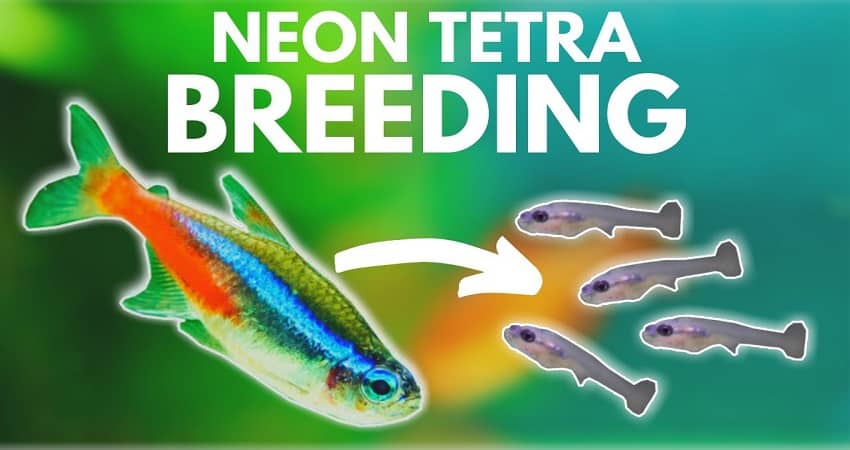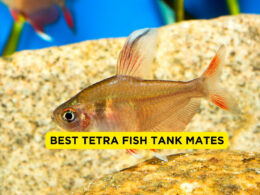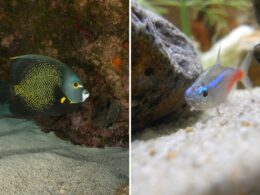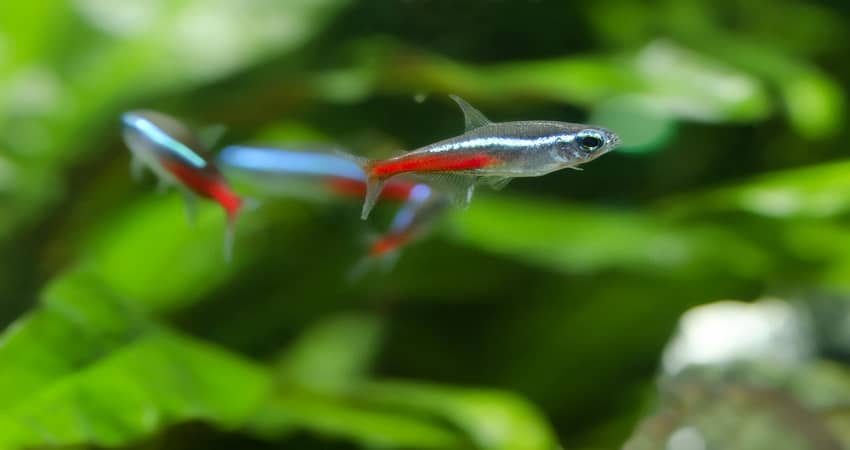In this article Show
Breeding neon tetras is a common thing that aquarists do to produce more neon tetras in a tank. Neon tetras require some knowledge of inbreeding as it is an easy task to do so long as the tank is in good condition for the process.
Despite it being easy, the breeding process is quite complicated; hence some people fail to handle it since the neon tetras lay eggs, and some end up eating the eggs, which becomes a challenge to the owner.
To prevent such issues in the tank, you must set the tank to its best production rate to reduce the breeding rate’s chances. It is good to set up a different tank for the breeding process to avoid eating the eggs or breaking them during the breeding process.
The owner must take care of the eggs by removing the layers from the tank after laying them as they start eating up the eggs. The tank conditions with their acidity, temperature, and light must be to the requirements of the neon tetras.
Below are the steps of breeding the neon tetras from the right first step of the breeding process by the owner to hatching day that shows the breeding process is to an end which increases the number of neon tetras in a particular tank.
Also worth reading;
- How To Sex Neon Tetras? (Male Or Female)
- Do Neon Tetras Lose Color at Night? – You Need to Know
- Neon Tetra vs. Cardinal Tetra: What Is the Difference?
- Do Neon Tetras Need Oxygen And Air Pump?
Steps Of Breeding Neon Tetras
The following are the steps to follow when breeding neon tetras;
1. Prepare The Breeding Tank
Preparing the breeding tank involves setting the tank condition in place by one getting a different tank for the breeding of the neon tetras.
Set the breeding tank about 30cm wide and 20cm high so that has enough space for the movement of the neon tetras when it is laying eggs.
The tank will be enough for the male and female neon tetras to be together, and there will be a space for the incubation of the eggs and the young neon tetras.
Ensure the tank is stable enough that it cannot bend during the breeding, creating room for light to penetrate, making the adult neon tetras see eggs for eating, and that water is in good conditions for breeding.
After setting the tank for use in the breeding process, it is time now to add water to the tank that the neon tetras will use for daily life. The water for breeding must be soft since neon tetras cannot survive in hard waters at about 77 degrees Fahrenheit such that the water is warm enough to facilitate the breeding rates.
The water must be acidic to some level, maintaining a PH scale of about 5 to 6 for good survival of the neon tetras.
With such conditions in the water, the neon tetra will have a smooth life in the breeding period, or sometimes it is good to keep checking the state of the tank in the breeding process, and this is by measuring the water temperatures after some hours with the acidity level of water to ensure it does not drop or go high as it can affect the breeding process.
Provide a filtration system in the tank after the conditions are correct by getting a box filter that mainly helps remove food remains in the tank or sometimes excess requirements that the neon tetras do not need.
The filtration system is essential as it reduces the chances of neon tetras having diseases. It removes bacteria that can cause diseases away from the tank and makes the home for the neon tetras breeding. The best filtrations to use in the tank are the corner box filters as they gently settle at one of the corners in the tank.
Lastly, in the tank preparation, set the tank in a place away from direct sunlight or a position that can access fewer amounts of light during the day and night since neon tetras are comfortable in dark areas.
Even though they love staying in dark places, they do not need sunlight since sunlight facilitates the growth of the neon tetra by providing some nutrients to their bodies. Therefore, set the tank in a place where it can get some light or place it in areas with light but regulate the excess light by covering the tank with a dark sheet to block the extra light.
2. Select The Tetras For Breeding
Select the female and male neon tetras ready for breeding and keep them in the different tanks that you are creating for the breeding process.
To differentiate the female and male neon tetras consider checking their sizes since the female neon tetras are larger than the male ones, and their bellies are round.
In addition to that, the female neon tetras have a blue line that curves on their bodies, while the male ones have a straight blue line. Always check the whole tank and choose a couple of neon tetras that are healthy and ready for breeding.
First, place the male neon tetras in the tank after sunset as it is best to put them in the new tank in the evening hours only if you want to breed them separately, but if you wish the breeding to happen, you can place the two of them in the separate tank.
Ensure the breeding tetras are older enough about three months old since younger neon tetras cannot facilitate breeding. Give some time for the neon tetras to live in the tank for more than two days for spawning.
If the neon tetras fail to breed, the tank must be having failures with its condition; therefore, check the conditions in the tank that set them to the requirements of the neon tetras to breed.
Keep adjusting the conditioner settings until the breeding happens by adding more soft water to the tank and measuring the temperatures plus the PH of the water. After breeding, remove the neon tetras in the tank immediately so long as you notice the availability of eggs in the tank.
Leaving the neon tetras after breeding in the tank can bring some losses as they start eating the eggs for reproduction. Give the eggs some 36 hours for the hatching of the younger neon tetras resulting from breeding.
3. Take Care Of The Neon Tetras, Young Ones
Since the younger neon tetras in the tank live without their parents, it is essential to provide good care for them by placing them in the dark for a few days after hatching.
They are sensitive to light. If the tank is in a direct light source, ensure you cover the tank to reduce the lights and only use the light for a short period when feeding them.
Provide appropriate foods to the neon tetras after hatching as they cannot eat the same food as the older neon tetras. The special foods for the young neon tetras are available in the specific shop as their food has names like baby tetras food or food for fry. You can then start feeding the baby tetras with baby brine shrimp for faster growth and development of the neon tetras.
After some weeks of hatching, the neon tetras are ready to live with the rest in the tank; hence, you are to bring them to live with the older neon tetras. Avoid introducing young neon tetras to the tank when they are still young as the older ones can eat them or bully them, weakening their body which later makes them die.
Ensure the tank has enough space by placing a neon tetra of 2 inches in a gallon tank; use the number of neon tetras you have to get the exact number of neon tetras in your tank. Overcrowding them can cause brutal death, and there is not enough space, and they can fight against each other as they struggle to get food or swim.
In case of more neon tetras at your place, ensure you get another tank for the neon tetras, or sometimes you can get more friends who are willing to keep the neon tetras at their places that you can give them so long as they have all the requirements and that they meet the preference of the neon tetras.
In case there is none, consider asking the pet store owners to buy one if they are interested.
You might be interested to know about Pregnant Neon Tetra
Conclusion
The article above shows the steps one can undertake when breeding neon tetras. The steps are easy to follow by just reading and preparing the neon tetras. The neon tetras require a few things to make their breeding process successful as they need water with their requirements and food, increasing the rates of producing eggs.
Therefore, ensure you follow the steps and ensure the tank’s conditions are correct since neon tetras are delicate and need certain water temperatures to survive.
In this video, I explain exactly how to breed the neon tetra in an aquarium. In particular, I use a piece of plastic canvas to divide the eggs from the adults.










